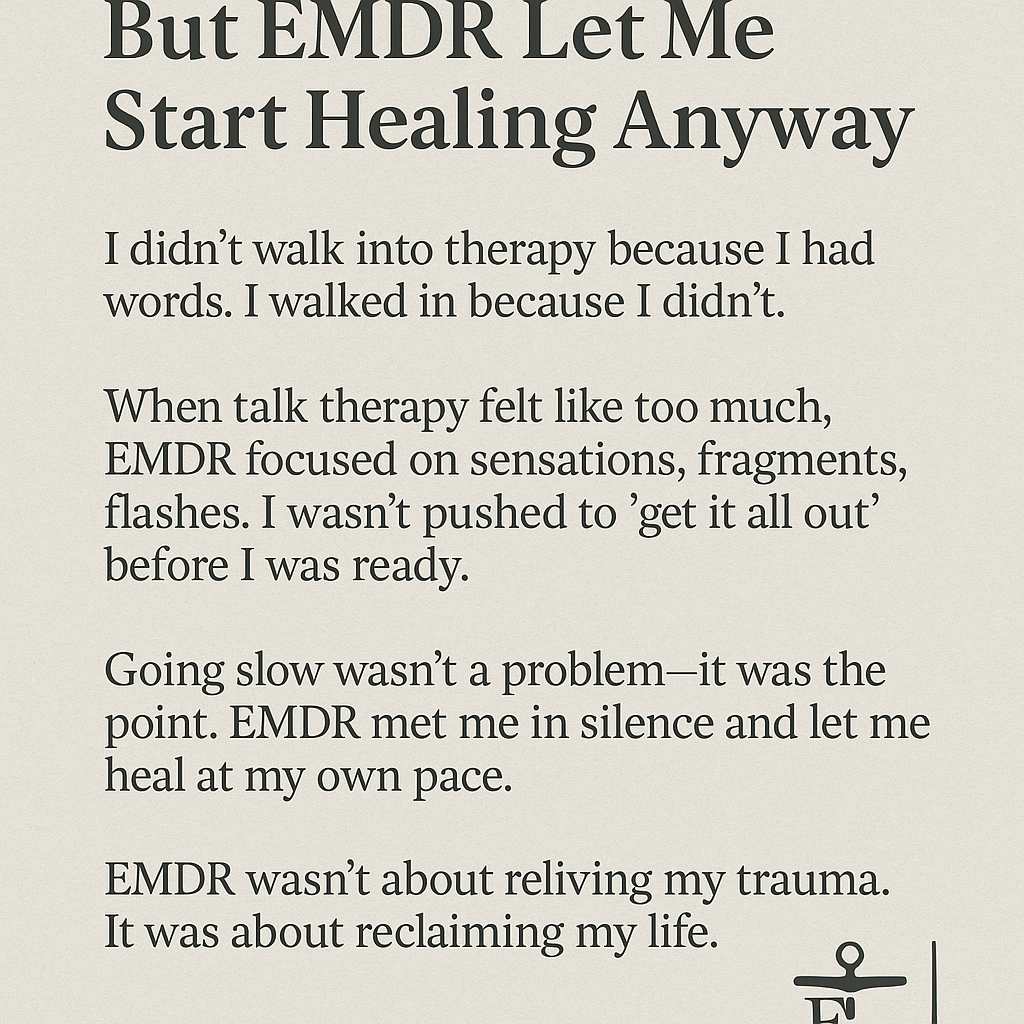I didn’t walk into therapy because I had words. I walked in because I didn’t.
There were things I couldn’t say—not because I didn’t want to, but because even thinking about them made my body shut down. I’d sit in a therapist’s office and feel the air leave the room. My hands would go cold. My throat would lock up. Sometimes, I’d nod along, pretend I was “processing.” But I wasn’t. I was surviving the session.
When Talk Therapy Felt Like Too Much
People talk a lot about the relief of opening up. But what if you can’t open up?
What if the thought of describing your trauma out loud feels like drowning?
That’s where I was. I wasn’t looking for insight or closure. I just needed the pain to stop echoing through my everyday life. The panic attacks. The numbness. The sudden jolts of memory I couldn’t control.
I wanted help. But traditional therapy—where you sit and speak and explain—felt impossible. Every session left me feeling more broken for not being able to do what others seemed to manage.
What EMDR Looked Like for Me
I’ll be honest. When someone first mentioned EMDR, it sounded…strange. Eye movements? Memory reprocessing? It felt clinical and vague at the same time. But I was desperate, and the therapist said something I’ll never forget:
“You don’t have to tell me everything. We can start with what’s coming up right now—in your body, not your story.”
That’s what made me stay.
EMDR didn’t require me to spill every detail. Instead, we worked with sensations, fragments, flashes. My therapist guided me through bilateral stimulation—following light with my eyes, tapping my hands—and I stayed anchored in the present, even as memories stirred.
It wasn’t always comfortable. Sometimes it left me raw, like something old had just been unburied. But it didn’t feel unsafe. I didn’t feel alone in it. And little by little, I stopped bracing for the past to punch through the present.
Going Slow Wasn’t a Problem—It Was the Point
One of my biggest fears was being pushed. Forced to “get it all out” before I was ready. EMDR didn’t do that.
It met me where I was—silent, guarded, scared—and gave me space to move at my own speed.
We paused often. My therapist always asked if I wanted to continue. Some sessions, I didn’t. And that was okay. That kind of safety was healing in itself. There was no expectation to be brave. No pressure to perform.
Healing wasn’t a straight line. It didn’t always look like progress. But EMDR helped me move in ways I couldn’t have through words alone. I learned to trust my own pace—and eventually, I learned to trust the process too.

When You Don’t Want to Die—But You Can’t Keep Living Like This
There were nights I didn’t want to be alive. Not because I had a plan—but because the weight of unspoken trauma made existing feel unbearable.
EMDR didn’t make everything okay overnight. But it helped me want to stay. It gave me proof that change—even quiet, slow, invisible change—was possible.
Some memories still sting. Some days are still heavy. But I don’t live inside the same pain loop anymore. And I don’t feel powerless to change it.
EMDR Wasn’t About Reliving My Trauma. It Was About Reclaiming My Life.
If traditional therapy hasn’t worked for you—or if you’ve never even made it that far—EMDR might be a different way in. One that honors your silence. One that respects your pace.
This kind of therapy isn’t about fixing you. It’s about helping you meet yourself in a place beyond survival. It’s about giving you options you didn’t know you had.
If you’re in Massachusetts and wondering whether this could help you too, know that you’re not alone. There are trauma therapists who will meet you without pressure, without expectation—just care.
Frequently Asked Questions About EMDR Therapy
What does EMDR stand for?
EMDR stands for Eye Movement Desensitization and Reprocessing. It’s a therapy method designed to help people heal from traumatic or distressing memories by engaging the brain’s natural processing system.
Do I have to talk about my trauma in detail for EMDR to work?
No. One of the strengths of EMDR is that it does not require you to describe the trauma in detail. The focus is on what’s happening in your mind and body in the present moment, and how those memories are stored.
What does a typical EMDR session look like?
After establishing safety and trust, your therapist may guide you through a memory or sensation using eye movements, tapping, or sound cues. These bilateral stimulations help your brain process and reframe traumatic memories.
Is EMDR only for PTSD?
No. While EMDR was originally developed for PTSD, it’s now used to treat anxiety, depression, panic, and other trauma-related conditions.
How long does EMDR therapy take?
That depends on the individual. Some people feel relief in a few sessions; others may work with a therapist for several months. Healing timelines vary—and that’s okay.
📞 Ready to try something different?
Call us at (888) 685-9730. You don’t have to tell your whole story. Just take the first step toward healing at your pace.








